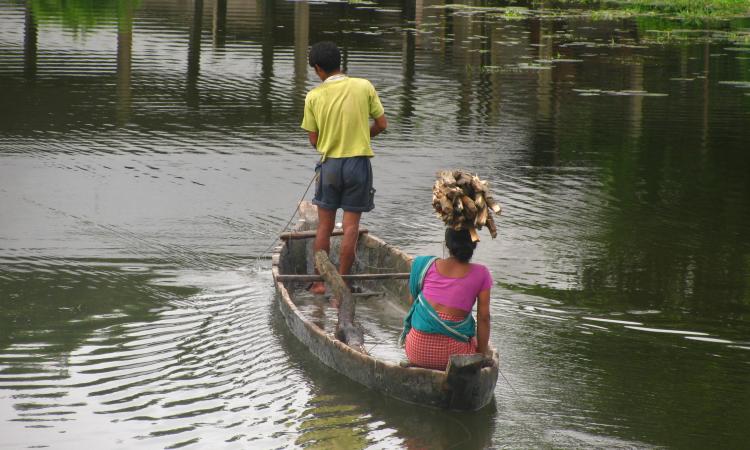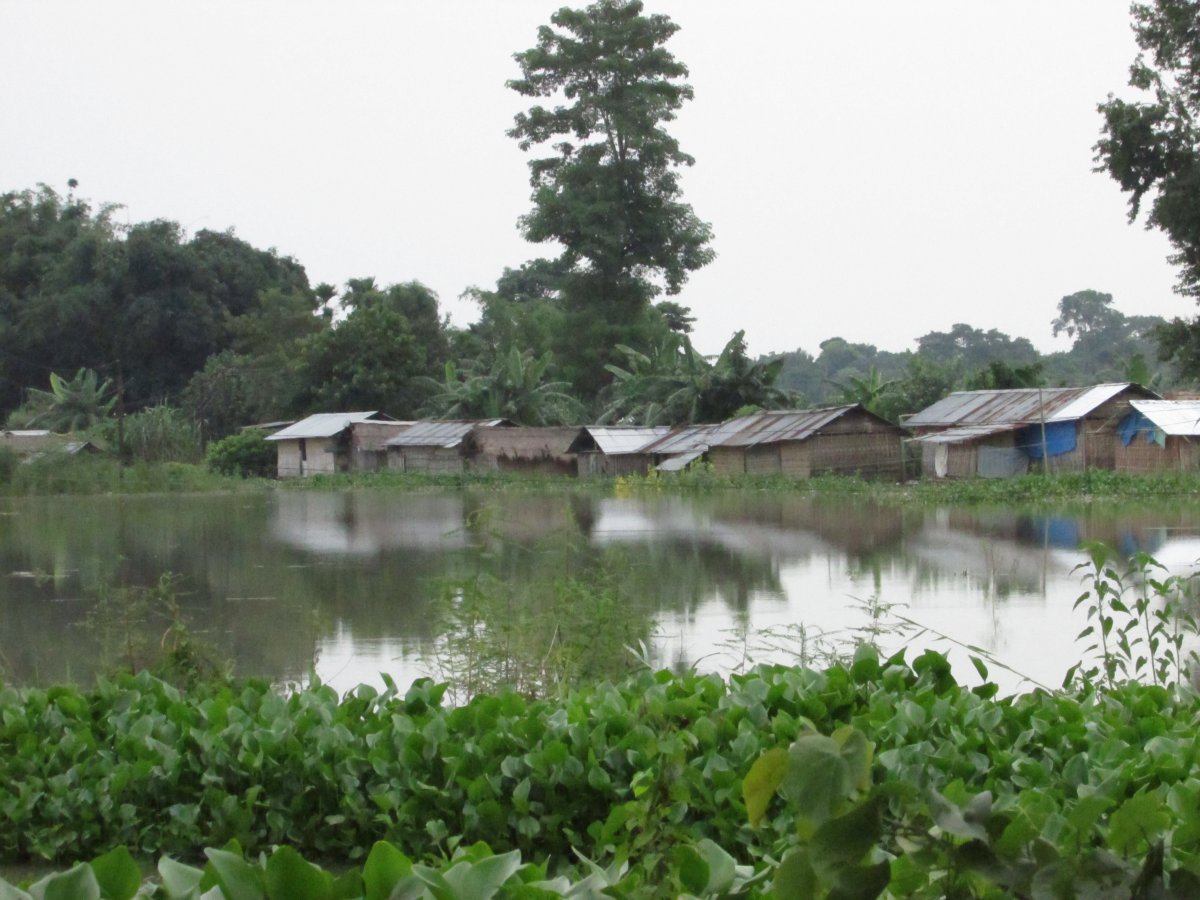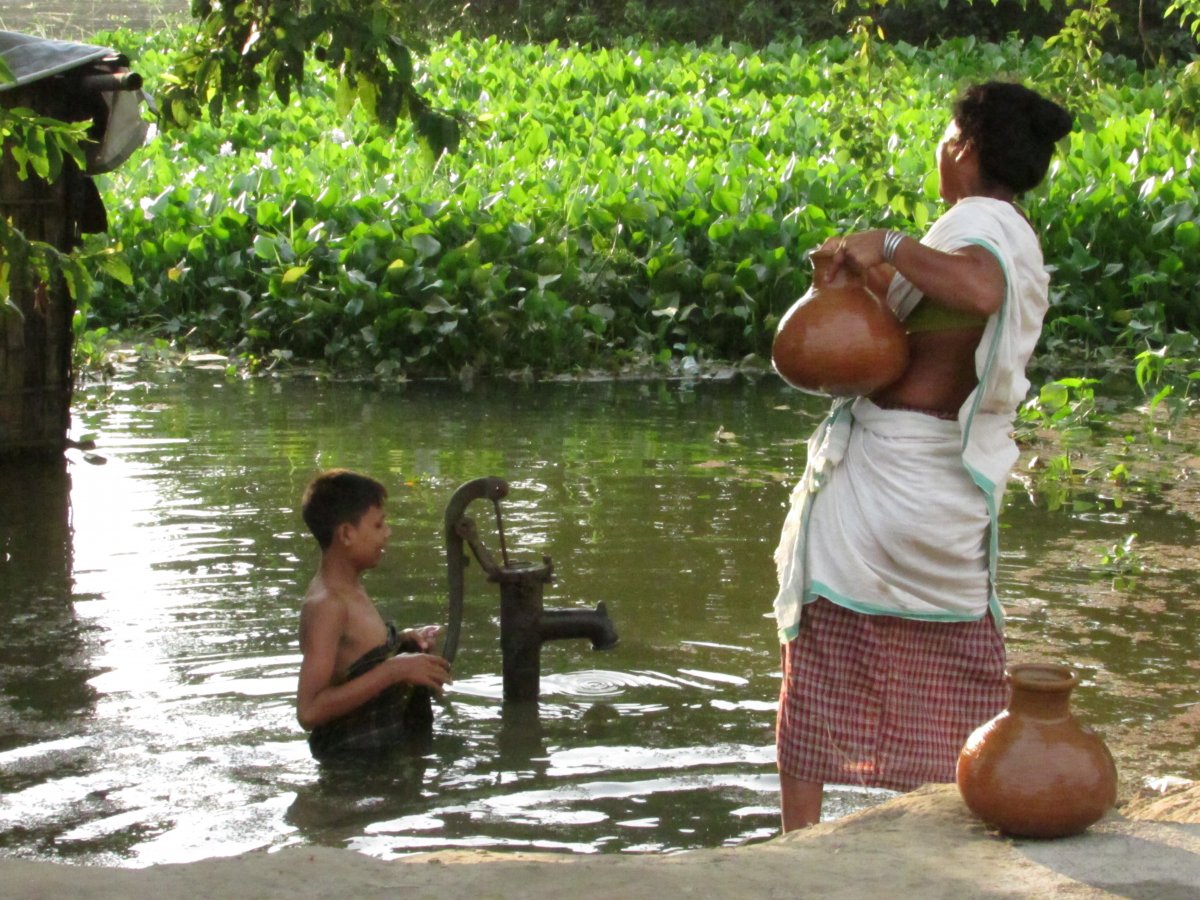
Floods are an annual phenomenon in Assam. They are as integral to the state as the Brahmaputra River is, and each monsoon, we are reminded that Assam exists (or is drowning). As I write this piece, Assam is slowly recovering from the first wave of flood this monsoon. For several weeks, the entire state was paralyzed; the death toll was reportedto be 69 (although it is likely to be higher); hundreds of wild animals have drowned, many in the Kaziranga National Park; and the lives and livelihoods of millions of people across 33 districts of the state were affected at large.
It is interesting to note that flood damages are often reported in the form of statistics, and at a macro scale. So, we refer to death toll, number of families affected, the area (hectarage) of cropland destroyed, and so on. This, however, misses out on the invisible everyday violence that floods inflict in their wake – violence that is so banal that it escapes flood meta-narratives, their statistics, and the attention of technocrats. Yet, such violence is extremely intimate, and its effect on people continues long after the floodwaters have receded. This article highlights such everyday experiences of flooding among rural communities in Assam, with a special reference to Majuli river island.

Loss, the fear of loss, and trauma
I was sitting with Pulin from Salmora village, Majuli, listenng to his account of a recent flood on Majuli island and how his family struggled to survive. The following is an excerpt from his long account:
The floodwater rose so fast and furious that we had to quickly decide what to protect and what all to let go [of]. We [i.e. the three brothers] worked all night, on empty stomachs, with tears in our eyes, loading the paddy grains onto our boat and transporting to the embankment, our temporary shelter. No light, strong water currents, snakes moving around, and we carried on like machines. My parents were both bed-ridden, and by midnight, the water level already touched their bed. We raised the bed by about two feet. By dawn, we were done transporting only about half of our grains, and all of a sudden, our parents screamed for help – we did not even realize when water level reached their bed again and they were about to be drowned. At that point, we gave up saving our grains - our hard-earned two seasons' harvest, and rushed immediately to rescue our elderly parents. I do not want to remember that night ever again, yet I cannot forget a single moment of it. I can’t get over that scream, and the very thought that my parents could have drowned still haunts me.
While all this was going on, Pulin’s small aluminum trunk was also washed away, along with some of his valuable possessions, including his favorite books (one of them being APJ Abdul Kalam’s autobiography, Wings of Fire, he emphasized), school prizes, letters, and other such irreplaceable items.

Sumoimari is another flood-ravaged village in Majuli, located alongside an embankment. I was sitting at Robiram Kutum’s house listening to his daughter’s tale of another major flood in the past and how it had left her father traumatized and literally speechless since. In that historic flood, Kutum lost over two hundred cattle overnight, all washed away in front of his eyes. For someone who depends on livestock rearing primarily as a source of income, this loss – and the very sight of his livestock washed away – was unbearable. It left Kutum so traumatized that he has since stopped socializing, talking, and stepping out of his home. The trauma was vivid on his face.
Flood and the everyday plight of women
In rural communities, women tend to bear the major brunt of flooding, and it is especially the case in the Brahmaputra Valley. Once again, some of these challenges are so mundane that they are hardly talked about. Nonetheless, these mundane, everyday challenges put the womenfolk through uniquely vulnerable positions. I highlight a few here:
When the toilets are submerged…
Most rural households in Majuli, especially among riverside communities, lack pukka toilets. The makeshift toilets, often located slightly away from the house, are submerged even in a low-intensity flood, making it extremely challenging for the population to defecate. While this poses inconvenience for both men and women, the latter suffer the most. In the absence of toilets, people rely on boats to go out and defecate. But defecating from a boat is neither simple nor does it allow for any privacy. It invariably requires an additional person on the boat who can hold the boat safely stationed in one location (sometimes against the current), with one side slightly tilted towards the water so that the other person can easily defecate and wash himself/herself.
For men, it may be possible to maneuver this task alone, given the kind of clothes that they wear, or at least they have the liberty to wear in public. But for women, often in mekhela-chador or other such elaborate attires, going out alone on a boat to defecate is next to impossible. Thus, women have no choice but to sacrifice their privacy. "Beyond inconvenience, it’s simply embarrassing for us, and it gets worse if we are on our period, too," said one woman in Salmora. Further, when an entire area is submerged, defecating from a boat is "open defecation" in its literal sense since there's really no place to hide. For women, surviving a flood is therefore a compromise with their everyday privacy, and a loss of basic dignity.
Submerged tube wells
 The plight of women is further exacerbated by the lack of access to potable water during floods. Again, lack of clean drinking water affects everyone, but it affects women the most because they are the ones who generally fetch water and cook for the family. Hence, they are doubly burdened when tube wells are submerged during floods. They have to either fetch water from someone else’s tube well that is not yet submerged or boil floodwater for drinking purpose. Either way, womens' workload increases, and in a flood situation, some of this additional workload may be dangerous, too.
The plight of women is further exacerbated by the lack of access to potable water during floods. Again, lack of clean drinking water affects everyone, but it affects women the most because they are the ones who generally fetch water and cook for the family. Hence, they are doubly burdened when tube wells are submerged during floods. They have to either fetch water from someone else’s tube well that is not yet submerged or boil floodwater for drinking purpose. Either way, womens' workload increases, and in a flood situation, some of this additional workload may be dangerous, too.
Human-animal conflicts during floods
While the drowning of wild animals in Kaziranga National Park makes it to the news, what is missing in the narrative is the escalation of human-animal conflicts in flood zones. Snakes are ubiquitous during floods. Although not all snakes are venomous, the very sight of snakes roaming around creates a deep sense of unease, sleeplessness and fear among people. With a couple of occasional deaths due to snake bites, this fear spreads like wildfire, at times causing more harm than good.
Sometimes, bigger animals such as wild elephants and rhinos also ended up in unusual habitats after escaping floods in Kaziranga. Again, these animals are highly stressed and unpredictable in such unnatural habitats, and the local people, too, are afraid with the sudden presence of such animals in their surroundings. Violent conflicts are imminent in such cases, and understandably so.
The impact of floods is multi-faceted. They can kill humans and animals, destroy property and infrastructure, and debilitate a population in the long run by wiping out their traditional livelihoods. All of this has been witnessed in Majuli, Assam at different points of time. At the same time, however, the impact of floods can also be mundane, felt at the level of the everyday. Flood events can cause all sorts of inconveniences, making daily activities near impossible; but they can also lead to excessive stress and trauma and they can cause daily indignities by compromising with one’s privacy. This everyday violence deserves as much attention as the catastrophic, headline-making attention that floods often get.
Mitul Baruah teaches Anthropology & Sociology at Ashoka University. Views are personal.